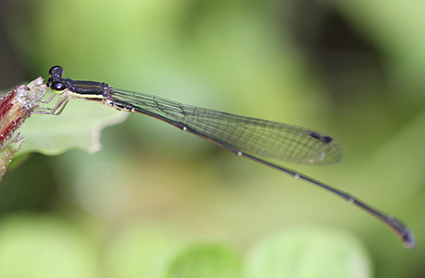Abstract
A new species of Forcepsioneura Lencioni, 1999 is described from seven males and three females (Holotype ♂ (FAAL NC 4521), Brazil, São Paulo, Monteiro Lobato—SP, 22° 57' 19'' S & 45° 50' 27'' W, 653 m, 28.xi.2010). The new species is compared with F. itatiaiae (Santos, 1970) its closest congener. Diagnostic illustrations are presented. The main differences between Forcepsioneura species are: in females, the posterior lobe of the prothorax and in males the shape of cerci and the posterior lobe of the prothorax. The species is named Forcepsioneura elizabethae sp. nov. in honor of Her Majesty Queen Elizabeth II on the occasion of her platinum jubilee.
References
Anjos-Santos, D. & Pessacq, P. (2012) Description of the last instar larva of Forcepsioneura sancta (Hagen in Selys 1860) (Odonata: Protoneuridae). Zootaxa, 3495 (1), 79–82. https://doi.org/10.11646/zootaxa.3495.1.5
Carle, F.L. & Wighton, D.C. (1990) Odonata. In: Grimaldi, D.A. (Ed.), Insects from the Santana Formation, Lower Cretaceous of Brazil. Bulletin of the American Museum of Natural History, New York, No. 195, pp. 51–68.
Dijkstra, K.-D.B., Kalkman, V.J., Dow, R.A., Stokvis, F.R. & Van Tol, J. (2014) Redefining the damselfly families: a comprehensive molecular phylogeny of Zygoptera (Odonata). Systematic Entomology, 39, 68–96. https://doi.org/10.1111/syen.12035
Lencioni, F.A.A. (1999) The genus Phasmoneura, with description of Forcepsioneura gen. nov. and two new species. Odonatologica, 28, 127–137.
Machado, A.B.M. (1999) Studies on Neotropical Protoneuridae. 9. Phasmoneura ciganae Santos, conspecific with Phasmoneura sancta (Hagen) comb. n. (Zygoptera). Notulae odonatologicae, 5 (3), 37–38.
Machado, A.B.M. (2000) Studies on Neotropical Protoneuridae. 10. Forcepsioneura lucia sp. n. from Parque Estadual Rola Moça, Minas Gerais, Brazil (Odonata: Zygoptera). Boletim do Museu de Biologia Mello Leitão, New Série, 11/12, 127–134.
Machado, A.B.M. (2001) Studies on Neotropical Protoneuridae. 11. Two new species of Forcepsioneura Lencioni (Odonata, Zygoptera) with a key to males of the genus. Revista Brasileira de Zoologia, 18 (3), 845–854. https://doi.org/10.1590/S0101-81752001000300021
Machado, A.B.M. (2004) Studies on Neotropical Protoneuridae. 15. Amazoneura gen. nov. with description of A. juruaensis sp. nov. (Odonata, Zygoptera). Revista Brasileira de Zoologia, 21, 333–336. https://doi.org/10.1590/S0101-81752004000200029
Machado, A.B.M. (2005) Forcepsioneura grossiorum spec. nov. from Brazil (Zygoptera: Protoneuridae) [Studies on neotropical Protoneuridae. 17]. Odonatologica, 34, 169–172
Pessacq, P. (2008) Phylogeny of Neotropical Protoneuridae (Odonata: Zygoptera) and a preliminary study of their relationship with related families. Systematic Entomology, 33, 511–528. https://doi.org/10.1111/j.1365-3113.2007.00414.x
Pimenta, A.L.A., Pinto, Â.P. & Takiya, D.M. (2019) Integrative taxonomy and phylogeny of the damselfly genus Forcepsioneura Lencioni, 1999 (Odonata: Coenagrionidae: Protoneurinae) with description of two new species from the Brazilian Atlantic Forest. Arthropod Systematics & Phylogeny, 77 (3), 397−415. https://doi.org/10.26049/ASP77-3-2019-2
Pinto, A.P. & Araujo, B.R. (2020) A new damselfly of the genus Forcepsioneura from the Atlantic Forest of south-eastern Brazil (Odonata: Coenagrionidae). Odonatologica, 49 (1/2), 107–123. https://doi.org/10.5281/zenodo.3823335
Pinto, A.P. & Kompier, T. (2018) In honor of conservation of the Brazilian Atlantic Forest: description of two new damselflies of the genus Forcepsioneura discovered in private protected areas (Odonata: Coenagrionidae). Zoologia, 35 (e21351), 1–19. https://doi.org/10.3897/zoologia.35.e21351
Riek, E.R. & Kukalova-Peck, J. (1984) A new interpretation of dragonfly wing venation based upon Early Upper Carboniferous fossils from Argentina (Insecta: Odonatoidea) and basic character states in pterygote wings. Canadian Journal of Zoology, 62 (6), 1150–1166. https://doi.org/10.1139/z84-166
Santos, N.D. (1968) Phasmoneura ciganae sp. n. e notas sobre outras espécies (Odonata : Protoneuridae). Atas da Sociedade de Biologia do Rio de Janeiro, 11 (6), 221–226.
Santos, N.D. (1970) Phasmoneura itatiaiae sp. n. (Odonata: Protoneuridae). Atas da Sociedade de Biologia do Rio de Janeiro, 13 (1/2), 25–26.
Selys-Longchamps, E. (1860) Synopsis des Agrionines. Dernière légion : Protoneura. Bulletin de l’Academie Royale de Belgique, 10 (2), 431–462. https://doi.org/10.5962/bhl.title.66021
Selys-Longchamps, E. (1886) Revision du Synopsis des agrionines. Première partie comprenant les legions Pseudostigma–Podagrion–Platycnemis et Protonevra. Mémoires couronnées et autres Mémoires, Académie royale de Belgique, 38 (4), i–vi + 1–233.
Tillyard, R.J. (1917) The Biology of Dragonflies: (Odonata or Paraneuroptera). University Press, Cambridge, 396 pp. https://doi.org/10.5962/bhl.title.27401
Vilela, D.S., Venâncio, H. & Santos, J.C. (2020) Forcepsioneura machadorum (Coenagrionidae: Protoneurinae) sp. nov. from the Cerrado Biome of Minas Gerais, southeastern Brazil. International Journal of Odonatology, 23 (4), 397–404. https://doi.org/10.1080/13887890.2020.1818640
Waller, J.T. & Svensson, E.I. (2017) Body size evolution in an old insect order: No evidence for Cope’s Rule in spite of fitness benefits of large size. Evolution, 71, 2178–2193. https://doi.org/10.1111/evo.13302
Williamson, E.B. (1916) A new dragonfly genus of the legion Protoneura (Odonata). Entomological News, 27, 30–33.


